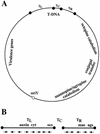Agrobacterium-mediated plant transformation: the biology behind the "gene-jockeying" tool
- PMID: 12626681
- PMCID: PMC150518
- DOI: 10.1128/MMBR.67.1.16-37.2003
Agrobacterium-mediated plant transformation: the biology behind the "gene-jockeying" tool
Abstract
Agrobacterium tumefaciens and related Agrobacterium species have been known as plant pathogens since the beginning of the 20th century. However, only in the past two decades has the ability of Agrobacterium to transfer DNA to plant cells been harnessed for the purposes of plant genetic engineering. Since the initial reports in the early 1980s using Agrobacterium to generate transgenic plants, scientists have attempted to improve this "natural genetic engineer" for biotechnology purposes. Some of these modifications have resulted in extending the host range of the bacterium to economically important crop species. However, in most instances, major improvements involved alterations in plant tissue culture transformation and regeneration conditions rather than manipulation of bacterial or host genes. Agrobacterium-mediated plant transformation is a highly complex and evolved process involving genetic determinants of both the bacterium and the host plant cell. In this article, I review some of the basic biology concerned with Agrobacterium-mediated genetic transformation. Knowledge of fundamental biological principles embracing both the host and the pathogen have been and will continue to be key to extending the utility of Agrobacterium for genetic engineering purposes.
Figures


References
-
- Abuodeh, R. O., M. J. Orbach, M. A. Mandel, A. Das, and J. N. Galgiani. 2000. Genetic transformation of Coccidioides immitis facilitated by Agrobacterium tumefaciens. J. Infect. Dis. 181:2106-2110. - PubMed
-
- Albert, H., E. C. Dale, E. Lee, and D. W. Ow. 1995. Site-specific integration of DNA into wild-type and mutant lox sites placed in the plant genome. Plant J. 7:649-659. - PubMed
-
- Albright, L. M., E. Huala, and F. M. Ausubel. 1989. Prokaryotic signal transduction mediated by sensor and regulator protein pairs. Annu. Rev. Genet. 23:311-336. - PubMed
-
- Al-Kaff, N. S., and S. N. Covey. 1996. Unusual accumulations of cauliflower mosaic virus in local lesions, dark green leaf tissue and roots of infected plants. Mol. Plant-Microbe Interact. 9:357-363.
Publication types
MeSH terms
LinkOut - more resources
Full Text Sources
Other Literature Sources
Miscellaneous

